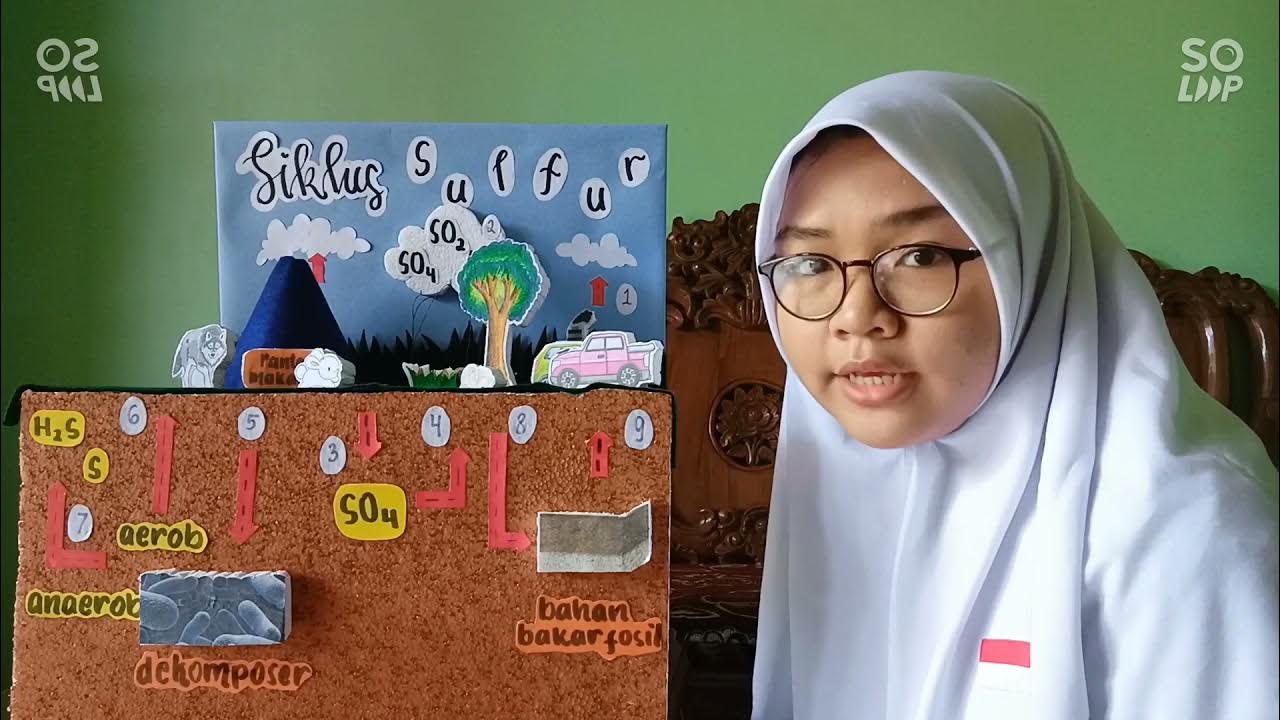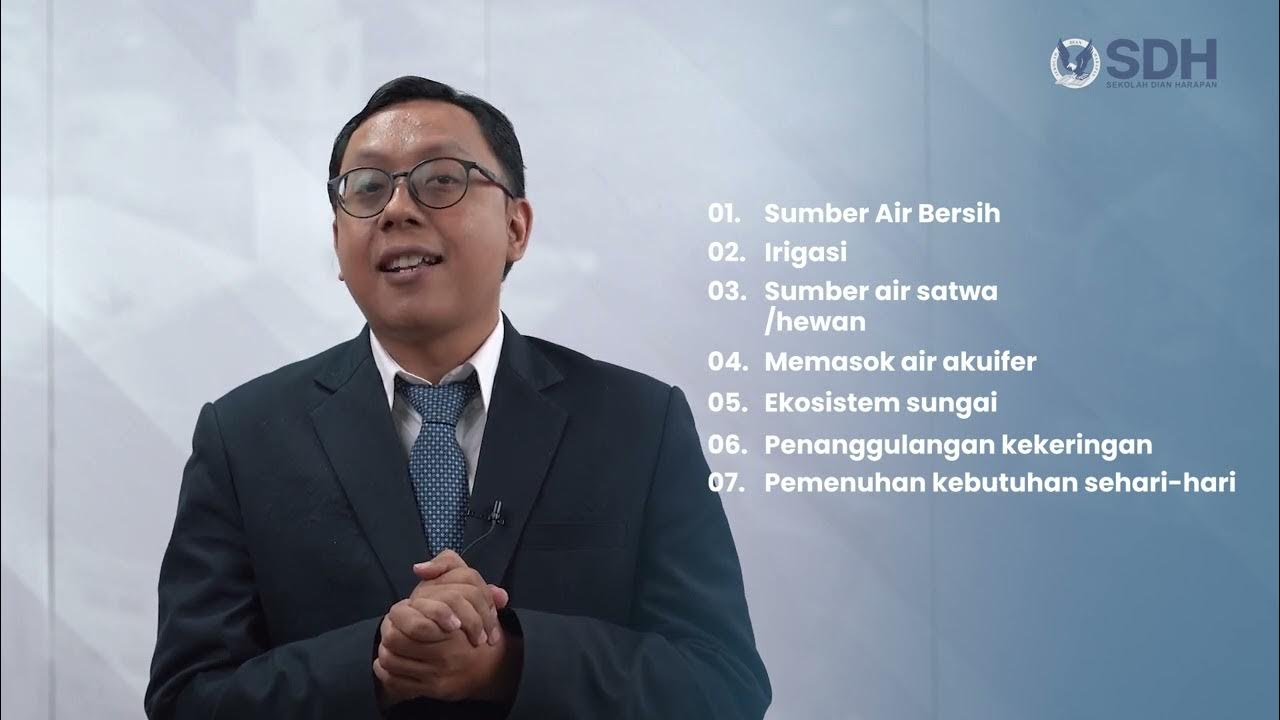Kelompok 4, Air Tanah (X-1)
Summary
TLDRThis video presentation, by a group of students, explores the importance of groundwater, its formation, and its role in sustaining ecosystems, agriculture, and industry. It explains the different types of groundwater, such as shallow and artesian water, and the process by which rainwater infiltrates and percolates into aquifers. The video emphasizes the need for conservation through methods like reforestation, waste management, and monitoring water quality. It also highlights the significance of groundwater in cultural contexts, referencing the legendary Zamzam well in Makkah. The group stresses the importance of preserving water for future generations.
Takeaways
- 😀 Air is a critical resource, and groundwater plays an important role as a clean water source for humans, agriculture, and industries.
- 😀 Groundwater is formed when rainwater seeps into the soil and flows beneath the surface due to gravity, geological structure, and soil moisture.
- 😀 Groundwater has two primary types: phreatic groundwater (shallow, close to the surface) and artesian groundwater (deeper, under pressure).
- 😀 The process of groundwater formation includes infiltration, where water seeps into the ground, followed by percolation, which filters the water naturally.
- 😀 Aquifers are layers of porous rock that store and transmit groundwater, and the water retained here is called groundwater.
- 😀 Shallow groundwater is susceptible to weather conditions and can be accessed through wells, while artesian groundwater is under pressure and provides better water quality.
- 😀 Groundwater can be categorized into three types: meteoric (from rainfall), tubir (deep below the surface), and juvenile (from volcanic activity).
- 😀 Groundwater is vital for domestic use, agriculture, industry, and maintaining environmental balance by supporting river flow during dry seasons.
- 😀 Proper groundwater conservation practices include constructing infiltration wells, reforestation, and careful water extraction to avoid depletion.
- 😀 The famous Zamzam well in Makkah, which has been providing water for thousands of years, illustrates the unique and miraculous nature of groundwater systems.
- 😀 Protecting groundwater quality requires measures such as waste management, preventing contamination, and maintaining balanced extraction practices for sustainability.
Q & A
What is groundwater, and how is it formed?
-Groundwater is water found beneath the Earth's surface, often formed when rainwater seeps into the soil and flows downward due to gravity, geological structure, and soil moisture. It eventually reaches aquifers, where it is stored and can be accessed by humans through wells.
What are the different types of groundwater mentioned in the script?
-The script mentions three types of groundwater: meteoric water, which originates from rainfall or snow; juvenile water, which comes from deep within the Earth due to volcanic activity; and connate water, which is trapped in rock layers deep underground and contains high mineral content.
What is the role of groundwater in maintaining environmental balance?
-Groundwater plays a crucial role in maintaining the environmental balance by supporting river flows during dry seasons, preventing soil erosion, and helping sustain ecosystems through consistent moisture levels in the soil.
How does groundwater filtration occur naturally?
-Groundwater undergoes natural filtration as it moves through different layers of soil and rock. During this process, impurities are filtered out, making the water cleaner before it reaches the aquifer.
What is the difference between phreatic and artesian groundwater?
-Phreatic groundwater is found near the surface, above an impermeable layer, and is influenced by weather conditions. It is easily accessible through dug or pumped wells. Artesian groundwater, on the other hand, is trapped between two impermeable layers and under pressure, making it easier to extract using deep wells without pumping, and it tends to have higher water quality.
What are the primary uses of groundwater?
-Groundwater is primarily used for drinking, agriculture (irrigation), industrial purposes (such as cooling machines), and supporting ecosystems through water flow into springs and rivers.
How can we conserve groundwater?
-Groundwater can be conserved by implementing measures such as creating infiltration wells, conducting reforestation efforts, using water judiciously, preventing contamination, and monitoring water levels regularly.
What is the significance of the Zamzam well mentioned in the script?
-The Zamzam well in Mecca is significant not only for its historical and spiritual importance but also for its geologic wonder. The well has never run dry despite being in a desert, and its water replenishes naturally through the groundwater system. Many people also believe that the water holds blessings due to its connection to religious history.
What are some environmental benefits of reforestation and greening efforts mentioned in the script?
-Reforestation and greening help prevent soil erosion, improve water absorption by the soil, and reduce surface water runoff, which helps maintain groundwater levels and quality.
Why is it important to monitor groundwater quality and quantity?
-Regular monitoring of groundwater is essential to detect potential problems early, such as over-exploitation, contamination, or declining water levels. This helps ensure a sustainable water supply for future generations.
Outlines

This section is available to paid users only. Please upgrade to access this part.
Upgrade NowMindmap

This section is available to paid users only. Please upgrade to access this part.
Upgrade NowKeywords

This section is available to paid users only. Please upgrade to access this part.
Upgrade NowHighlights

This section is available to paid users only. Please upgrade to access this part.
Upgrade NowTranscripts

This section is available to paid users only. Please upgrade to access this part.
Upgrade Now5.0 / 5 (0 votes)





